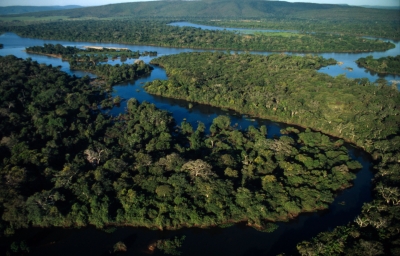
The world’s largest tropical wetland, the Pantanal is a natural region in South America. Lying mostly in Brazil and spilling into neighbouring Bolivia and Paraguay, this wetland covers a whopping area of more than 1,81,000 sq.km. Within this large area, several subregional ecosystems thrive, each with its own distinctive characteristics. Though the Amazon rainforest is easily synonymous with the natural landscape and wildlife of South America, surprisingly it is the Pantanal region that has the highest concentration of wildlife in this continent. Annually, the Pantanal’s vast basin gets flooded after torrential rains. After these rains, the water slowly drains into the Paraguay river, creating lakes and pools. Filled as they are with fishes and snails, these waterbodies attract a large variety of birds, including storks. The hyacinth macaw, the largest species of parrot, can be seen in the area. The vegetation in the region too is just as varied with giant water lilies rubbing shoulders with cactus!
Comprising a group of four contiguous protected areas, the Pantanal Conservation Area was declared a UNESCO World Heritage Site in 2000. As always, human activity is a grave concern in the area. These include sport fishing, the disturbance of nesting areas, and development projects such as the plan to construct navigable water courses.
Wildlife
Among the birds spotted in the region are tinamous, grebes, ducks, teals, guans, swans, pigeons, doves, cuckoos, nighthawks, nightjars, hermits, swifts, hummingbirds, crakes, rails, gallinules, stilts, lapwings, plovers. jacanas, sandpipers, godwits, snipes, terns, bitterns, storks, cormorants, herons, ibises, spoonbills, vultures, caracaras, ospreys, kites, owls, trogons, kingfishers, puffbirds, jacamars, toucans, piculets, woodpeckers, falcons, kestrels, parakeets, macaws, woodcreepers, spinetails, thornbirds, jays, martins, swallows, flycatchers, wrens, thrushes, mockingbirds, warblers, seedeaters, finches, and sparrows. The animals from the region include jaguars, green anacondas, giant armadillos, giant anteaters, otters, wild pigs, marsh deer, howler and capuchin monkeys, capybaras (world’s largest rodents), in addition to caimans, alligators, and a range of amphibians, reptiles, and insects.
Threats
The Pantanal waterways are crucial for life in the region, but face several threats such as deforestation, soil erosion from expanding industrial agriculture, and infrastructure projects. It is said that because the land around the eco-rich Pantanal region is relatively inexpensive, over the years, many farmers from other parts of Brazil have begun agriculture here. This means the agrichemical runoff is high. According to WWF Brazil’s report a few years ago, as many as “30% of springs that feed the Pantanal are at ecological risk and require urgent action”. Much to the disappointment of activists and conservationists, a few years ago “the buffer zone necessary between farmland and river springs” was reduced, which could prove disastrous for the Pantanal in the long run. An unusual form of threat arising from agriculture is the killing of jaguars by farmers since the big cats kill their cattle. In the long run, if the jaguar disappears from the region it could throw the ecosystem into a disarray since it’s at the top of the food chain. Another cause of concern is the lack of humanpower to police the region to see if there’s encroachment, soil erosion, etc. In addition, the increasing use of hydroelectric dams to create energy in the region is also a major threat”. In 2020, the Pantanal was exceptionally dry and burning at a record rate.
Picture Credit : Google




